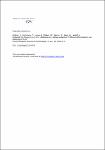Reduced Treg frequency in LFA-1-deficient mice allows enhanced T effector differentiation and pathology in EAE
Gültner, Sandra
Kuhlmann, Tanja
Hesse, Amke
Weber, Jan P.
Riemer, Constanze
Baier, Michael
Hutloff, Andreas
The αLβ2-integrin LFA-1 (CD11a/CD18) is known as an important molecule for leukocyte migration. However, the precise role of LFA-1 in the pathogenesis of EAE has so far remained unclear. We describe here the disease development in LFA-1(-/-) mice compared with WT controls. Ablation of LFA-1 resulted in more severe EAE with increased demyelination and increased numbers of myelin oligodendrocyte glycoprotein-reactive CD4(+) T cells in the CNS. However, the production of the pro-inflammatory cytokines IL-17 and IFN-γ was unchanged on the level of antigen-specific T cells. Interestingly, LFA-1-deficient mice showed a clearly reduced frequency of Treg in the inflamed CNS. Moreover, Treg counts in spleens and thymi of unimmunized LFA-1(-/-) mice were lower in comparison to the WT controls, indicating an impairment of Treg generation. In combination, these results suggest a substantial role of LFA-1 in Treg generation and subsequent expansion of effector T cells and highlight the importance of Treg in limiting EAE.
Dateien zu dieser Publikation
Keine Lizenzangabe

